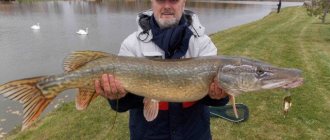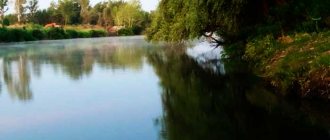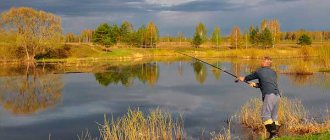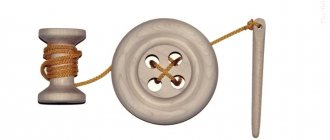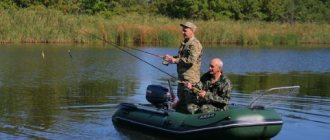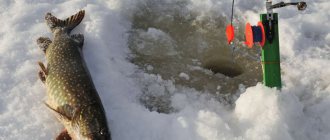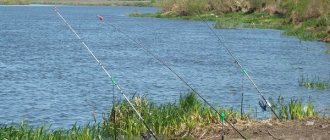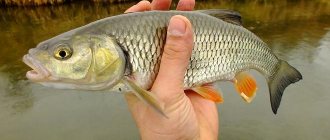Winter is in full swing and lovers of winter fishing do not miss the opportunity to get out and sit with a fishing rod. What attracts fishing in January? First of all, the fact that the wilderness has not yet arrived - there is a bite, the main thing is to choose the right place to fish. Fishermen prefer reservoirs with running water, because in small ones the fish are sluggish from oxygen starvation. Fishing in January is good for pike, pike perch, perch, bream, roach and crucian carp bite well, you can also catch burbot in those places where the spawning ban has not begun. Let's find out how to fish in January.
Where to fish in January
Experienced anglers know that fish behave differently in January. In some places the bite is active, while in others there is complete calm. The reason is simple. In small closed reservoirs, rich in aquatic vegetation, oxygen dissolved in water is much less than in large and deep ones.
Oxygen is intensively consumed by the decomposing remains of plants that have sunk to the bottom; fish leave such places, and where it is impossible to leave, they die from starvation. You should especially carefully choose fishing spots in January, taking into account information about them from previous years and the current season. Preference should be given to large reservoirs and rivers that are not polluted by industrial waste.
- fishing in small reservoirs in January can leave you without a catch - in shallow, overgrown and silted reservoirs, where in winter the water is almost not enriched with oxygen, the fish becomes inactive, sick, loses appetite and does not take bait at all.
- Fishing in January on rivers and reservoirs is always productive - in deep lakes and reservoirs, mainly with clean and running water, it is easier for the fish to breathe, and they continue to feed.
The fisherman's calendar for January advises looking for fish in January in flowing reservoirs with springs, underwater springs and areas with a non-freezing water surface, with a favorable oxygen regime. Fish choose places for their stops where they can find food. In rivers with a constant flow, it also feeds in certain, limited areas (fat areas).
Choosing a reservoir and searching features
Flowing reservoirs are considered more promising for catching bream and bream in winter. The current mixes the layers of water, thereby maintaining the level of oxygen necessary for the fish to function properly. That is why in the cold season the activity of river bream is higher than its counterpart living in reservoirs and large lakes. On stagnant reservoirs in the dead of winter, there will be little chance, if at all, you will be lucky enough to see at least one bite. Especially during sudden changes in weather conditions. When the barometer goes down, trying to catch bream in still water becomes a waste of time. Pleasure can only be obtained from being in the fresh air.
For fishing, it is best to choose a frosty day, preferably without wind. In such weather, large bream is located at a comfortable depth of 5-7 meters, at which weather vagaries have less impact on its well-being. The flock chooses areas with soft soil that provides it with food - small crustaceans and various bottom worms. The breams behave more actively. During thaws, they can come quite close to the shore, to depths of up to 2 meters, where the clean bottom borders on decaying coastal vegetation. In relatively shallow water, they do not appear to bask at all. The plant remains are full of different living creatures, which attract small bream.
What are the signs to determine the presence of bream? Experienced ice fishing enthusiasts begin their search with such promising areas as:
- flooded old riverbeds;
- river turns under steep banks;
- the confluence of rivulets, canals, streams that bring life-giving oxygen;
- channel edges and other deep irregularities;
- snags at a depth of at least 4-5 meters.
Over the years of practice, many winter anglers have come to the conclusion that in areas with a relief bottom the concentration of bream is always higher. Even in summer they prefer to stay where there are differences in depth, various hills and holes, and in winter they are drawn to such places like a magnet. To quickly find bottom irregularities in a little-studied body of water, you will need an echo sounder. Otherwise, you will have to drill many holes, spending a lot of time searching.
When is the best time to fish in January?
Changing weather and sudden changes in temperature do not contribute to a stable fish bite in January. As the fisherman’s calendar for January emphasizes, the fish bite fades compared to December, and in some reservoirs it almost stops. On what days of the month will fishing in January be more successful? Experienced fishermen note that greater success in fishing was observed on calm, quiet days with light winds, especially after severe frosts and snowstorms.
The most favorable time for fishing in January is:
- long thaws after severe frosts;
- quiet days with stable temperatures down to -10°;
A change in bite can occur due to several factors:
- sudden change in temperature;
- drop or increase in pressure;
- when there is a strong north wind.
The lack of fish biting in January at feeding areas on certain days and even periods is associated with unfavorable meteorological conditions:
- sudden changes in barometric pressure and temperature,
- heavy rainfall,
- strong winds from the north, northeast, northwest and east.
Fish behavior in winter
At the beginning of the winter period, most underwater inhabitants after a short-term shock associated with the establishment of ice on water bodies. But this condition does not last very long, from five days to a week. Usually the ice gets stronger during this time, and anglers do not notice some fish stupor.
Attention! It is recommended to go out on the ice when its thickness reaches 20 centimeters!
Then comes the real rush of the first ice, when almost all the fish that are not hibernating begin to bite. In central Russia these are the following species:
- pike;
- pike perch and bersh;
- perch;
- bream;
- roach;
- silver bream;
- burbot;
- sopa;
- chub;
- ruff;
- subdust;
- dace.
Some underwater inhabitants become active either during certain periods, for example during a thaw, or in individual bodies of water. These include:
- crucian carp;
- carp;
- carp;
- bleak;
- rotana.
By January, the activity of most species decreases; fishermen need to put in more effort and skill to end up with a catch. This partly explains the fact that the number of “penguins” on the ice in the first month of the year is noticeably reduced. Freeloaders who have successfully fished in the first ice cover their gear until spring.
What fish to catch in January
In lakes and reservoirs, under favorable weather conditions, perch, ruffe, roach, and bream are caught with float rods. The bite is better if you use bait (small bloodworms, crumpled boiled potatoes, various cereals, etc.).
Chub can be caught in medium-flow rivers; good places are near steep banks, where the depth is 0.8 - 2 meters. The one that is least affected by the cold is the burbot. This voracious predator spawns in the cold, it is successfully caught on the bottom, and instead of bait they use gudgeon, roach, and ruff. Toothed pike are successfully caught on winter baits.
On lakes and small reservoirs you should look for it at maximum depth, and on rivers and large reservoirs - in holes, depth changes, whirlpools, next to reeds, etc.
In the morning at dawn and in the evening in deep and rocky places, pike perch is not bad at catching with a spoon. The spoons are narrow and medium in size. But perch prefers a small spinner or a balancer; it can be caught using a jig with or without an attachment.
What gear should you take with you fishing?
January on Akhtuba will be especially successful if you prefer lure fishing. According to the fishing calendar, in the first half of the month, using the vertical lure method, it is possible to ensure a massive catch of pike perch and perch (in quiet waters). Pike are often caught on the girders during the thaw period. Note that on January days, pike are caught on girders both in eriks and in lakes. Using a jig in a closed floodplain reservoir, there is a high chance of adding perch, roach, and even the rather rare rudd to the trophy list.
At this time, a stable catch of bersh and pike perch is observed in Trekhrechye. When there is a strong thaw, catfish and carp are caught under the steep banks (for a guaranteed successful entry, use a vertical spoon).
When the middle of winter is greeted with relative warmth, and the ice still refuses to “stand up,” it’s time to resort to spinning fishing. If you are a fan of jigging, you can catch pike perch at impressive depths, but first you need to figure it out. You can also catch it by trolling, and feel free to count on a large specimen. The same applies to catfish.
Fishing in January and safety
We should not forget about this insidious phenomenon, characteristic of Russian reservoirs: during heavy snowfalls, the ice shell of rivers and lakes is covered with a thick snow cushion, the snow presses on the ice and under its weight it cracks and sinks, in such places water appears, which does not freeze under the thick - a layer of snow.
Be careful! Also be careful when choosing fishing in January near populated areas. Large holes cut out and ice holes hidden under the snow are a huge danger for the fisherman.
Danger awaits the fisherman in areas of the reservoir where there are springs. The ice here is thin, and under the snow layer it is not visible. River rapids with fragile ice cover can also be unpleasant. Therefore, in unfamiliar places, before taking a step, you need to check the strength of the ice with an ice pick.
Andrey Shalygin
Read expert opinions
About the features of fishing described in the article
chub
ruff
bream
burbot
perch
roach
zander
pike
ide
About the features of the types of fishing described in the article
winter types of fishing
Get basic knowledge
About the fish mentioned in the article
chub
ruff
bream
burbot
perch
roach
zander
pike
ide
About the types of fishing mentioned in the article
winter types of fishing
Fishing tourism
Guided Fishing – Catch the fish mentioned in the article
chub
ruff
bream
burbot
perch
roach
zander
pike
ide
January fishing: video
Today there will be several videos especially for winter fishing lovers.
One of them is about winter fishing on the Pavlovsk Reservoir
Night fishing in early January on the Ivankovskoye Reservoir
And a bonus will be a video about winter fishing in Finland. A large pike from Lake Saimaa unbends the winding rings of the girder at once. Enjoy watching
If you liked the article, share it with your friends! Thank you!
